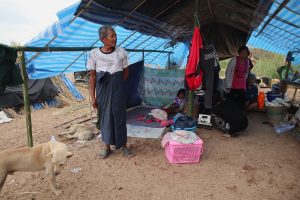Today, Reuters published a report quoting a senior Thai official about the country’s new humanitarian initiative on Myanmar, which was agreed last week by the Association of Southeast Asian Nations (ASEAN).
At the close of their informal meeting in Luang Prabang, ASEAN foreign ministers and a representative from Myanmar’s military junta endorsed Thailand’s initiative to establish a humanitarian corridor to provide aid for civilians displaced by the country’s intensifying civil war.
Under the arrangement, the Thai and Myanmar Red Cross will deliver supplies to populations in need under the observation of the ASEAN Coordinating Center for Humanitarian Assistance on Disaster Management, often referred to as the AHA Center.
The Reuters report included remarks from Sihasak Phuangketkeow, Thailand’s vice foreign minister, which offered some more details on the arrangement. First off, Sihasak said that Thailand plans to establish a humanitarian safe zone later this month close to the Mae Sot-Myawaddy crossing, a long-time center of humanitarian outreach to refugees from Myanmar. This will be used to deliver food and medical supplies to local communities and around 20,000 people displaced by the fighting that has enveloped the country since the military coup of February 2021.
More ambitiously, the report quoted Sihasak as saying that the initiative would supplement ASEAN’s Five-Point Consensus peace plan with the ultimate aim of bringing about talks between the military junta and its opponents, including the National Unity Government (NUG) and ethnic resistance groups.
“Some kind of a dialogue process should begin maybe at least by the middle of the year,” Sihasak said, adding that Thailand had already consulted with various international partners, including India and China.
“It’s about paving the way for Myanmar to once again reengage and engage constructively with the international community,” he said. “This is an opportunity for some dialogue, constructive dialogue, to begin.”
Sihasak’s remarks are the latest sign of a marked shift in Thailand’s position on Myanmar since Prime Minister Srettha Thavisin took office last year. In some ways, this is only to be expected, given that Thailand has historically experienced the most direct backwash from Myanmar’s long-running civil war. As Sihasak said, “We don’t want to see a Myanmar that is destabilized further.”
Leaving aside the important question of whether the provision of humanitarian aid via the administration run by the country’s military – the one actor in Myanmar most responsible for creating the current emergency – can hope to effectively address the crisis, the new Thai approach appears to remain limited. Which is to say, while it is positive that Thailand is no longer advancing a pro-junta policy, the new policy fails to transcend the tightly circumscribed terms of ASEAN’s Five-Point Consensus.
Agreed at a special meeting in Jakarta in April 2021, the Consensus has called for an immediate end to violence in Myanmar and the convening of political dialogue involving “all parties” to the country’s conflict. However, the core flaw in the Consensus is its assumption that the military administration led by Senior Gen. Min Aung Hlaing is interested in reaching a political accommodation with opponents that it views as “terrorists.”
From the other side, too, the resistance forces are unlikely to concede any compromise that preserves a political role for the military, as the NUG laid out in an important position paper released last week. The paper said that the NUG, and the two armed resistance groups with whom it released the policy statement, are only open to negotiations with the military “subject to their unconditional acceptance” of its six political objectives. The first of these is to “reverse the coup and terminate the involvement of the armed forces in politics,” and the second, is to place the military under the control of a democratically elected civilian government.
In other words, Thailand’s apparent shift in policy remains one of degree rather than of kind. The fact remains that three years on from the military’s disastrous military coup, the two contending sides of Myanmar’s conflict still see the battlefield as the main way of fulfilling their political goals. The shift in Thailand’s stance is welcome, and could conceivably open a path forward through the thickets of conflict – but only once the balance of power inside the country shifts decisively enough to change one side’s calculus.

































